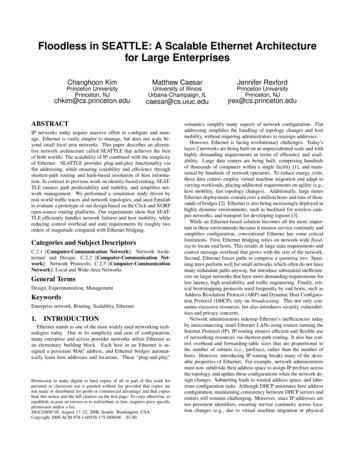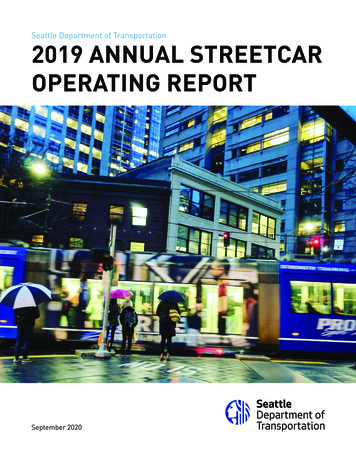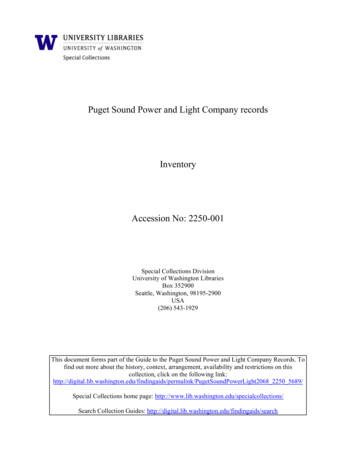
Transcription
Floodless in SEATTLE: A Scalable Ethernet Architecturefor Large EnterprisesChanghoon KimMatthew CaesarJennifer RexfordPrinceton UniversityPrinceton, NJUniversity of IllinoisUrbana-Champaign, ILPrinceton UniversityPrinceton, IP networks today require massive effort to configure and manage. Ethernet is vastly simpler to manage, but does not scale beyond small local area networks. This paper describes an alternative network architecture called SEATTLE that achieves the bestof both worlds: The scalability of IP combined with the simplicityof Ethernet. SEATTLE provides plug-and-play functionality viaflat addressing, while ensuring scalability and efficiency throughshortest-path routing and hash-based resolution of host information. In contrast to previous work on identity-based routing, SEATTLE ensures path predictability and stability, and simplifies network management. We performed a simulation study driven byreal-world traffic traces and network topologies, and used Emulabto evaluate a prototype of our design based on the Click and XORPopen-source routing platforms. Our experiments show that SEATTLE efficiently handles network failures and host mobility, whilereducing control overhead and state requirements by roughly twoorders of magnitude compared with Ethernet bridging.Categories and Subject DescriptorsC.2.1 [Computer-Communication Network]: Network Architecture and Design; C.2.2 [Computer-Communication Network]: Network Protocols; C.2.5 [Computer-CommunicationNetwork]: Local and Wide-Area NetworksGeneral TermsDesign, Experimentation, ManagementKeywordsEnterprise network, Routing, Scalablity, Ethernet1.INTRODUCTIONEthernet stands as one of the most widely used networking technologies today. Due to its simplicity and ease of configuration,many enterprise and access provider networks utilize Ethernet asan elementary building block. Each host in an Ethernet is assigned a persistent MAC address, and Ethernet bridges automatically learn host addresses and locations. These “plug-and-play”Permission to make digital or hard copies of all or part of this work forpersonal or classroom use is granted without fee provided that copies arenot made or distributed for profit or commercial advantage and that copiesbear this notice and the full citation on the first page. To copy otherwise, torepublish, to post on servers or to redistribute to lists, requires prior specificpermission and/or a fee.SIGCOMM’08, August 17–22, 2008, Seattle, Washington, USA.Copyright 2008 ACM 978-1-60558-175-0/08/08 . 5.00.jrex@cs.princeton.edusemantics simplify many aspects of network configuration. Flataddressing simplifies the handling of topology changes and hostmobility, without requiring administrators to reassign addresses.However, Ethernet is facing revolutionary challenges. Today’slayer-2 networks are being built on an unprecedented scale and withhighly demanding requirements in terms of efficiency and availability. Large data centers are being built, comprising hundredsof thousands of computers within a single facility [1], and maintained by hundreds of network operators. To reduce energy costs,these data centers employ virtual machine migration and adapt tovarying workloads, placing additional requirements on agility (e.g.,host mobility, fast topology changes). Additionally, large metroEthernet deployments contain over a million hosts and tens of thousands of bridges [2]. Ethernet is also being increasingly deployed inhighly dynamic environments, such as backhaul for wireless campus networks, and transport for developing regions [3].While an Ethernet-based solution becomes all the more important in these environments because it ensures service continuity andsimplifies configuration, conventional Ethernet has some criticallimitations. First, Ethernet bridging relies on network-wide flooding to locate end hosts. This results in large state requirements andcontrol message overhead that grows with the size of the network.Second, Ethernet forces paths to comprise a spanning tree. Spanning trees perform well for small networks which often do not havemany redundant paths anyway, but introduce substantial inefficiencies on larger networks that have more demanding requirements forlow latency, high availability, and traffic engineering. Finally, critical bootstrapping protocols used frequently by end hosts, such asAddress Resolution Protocol (ARP) and Dynamic Host Configuration Protocol (DHCP), rely on broadcasting. This not only consumes excessive resources, but also introduces security vulnerabilities and privacy concerns.Network administrators sidestep Ethernet’s inefficiencies todayby interconnecting small Ethernet LANs using routers running theInternet Protocol (IP). IP routing ensures efficient and flexible useof networking resources via shortest-path routing. It also has control overhead and forwarding-table sizes that are proportional tothe number of subnets (i.e., prefixes), rather than the number ofhosts. However, introducing IP routing breaks many of the desirable properties of Ethernet. For example, network administratorsmust now subdivide their address space to assign IP prefixes acrossthe topology, and update these configurations when the network design changes. Subnetting leads to wasted address space, and laborious configuration tasks. Although DHCP automates host addressconfiguration, maintaining consistency between DHCP servers androuters still remains challenging. Moreover, since IP addresses arenot persistent identifiers, ensuring service continuity across location changes (e.g., due to virtual machine migration or physical
mobility) becomes more challenging. Additionally, access-controlpolicies must be specified based on the host’s current position, andupdated when the host moves.Alternatively, operators may use Virtual LANs (VLANs) to buildIP subnets independently of host location. While the overhead ofaddress configuration and IP routing may be reduced by provisioning VLANs over a large number of, if not all, bridges, doing soreduces benefits of broadcast scoping, and worsens data-plane efficiency due to larger spanning trees. Efficiently assigning VLANsover bridges and links must also consider hosts’ communicationand mobility patterns, and hence is hard to automate. Moreover,since hosts in different VLANs still require IP to communicate withone another, this architecture still inherits many of the challengesof IP mentioned above.In this paper, we address the following question: Is it possible tobuild a protocol that maintains the same configuration-free properties as Ethernet bridging, yet scales to large networks? To answer,we present a Scalable Ethernet Architecture for Large Enterprises(SEATTLE). Specifically, SEATTLE offers the following features:A one-hop, network-layer DHT: SEATTLE forwards packetsbased on end-host MAC addresses. However, SEATTLE does notrequire each switch to maintain state for every host, nor does it require network-wide floods to disseminate host locations. Instead,SEATTLE uses the global switch-level view provided by a linkstate routing protocol to form a one-hop DHT [4], which stores thelocation of each host. We use this network-layer DHT to builda flexible directory service which also performs address resolution (e.g., storing the MAC address associated with an IP address),and more flexible service discovery (e.g., storing the least loadedDNS server or printer within the domain). In addition, to providestronger fault isolation and to support delegation of administrativecontrol, we present a hierarchical, multi-level one-hop DHT.Traffic-driven location resolution and caching: To forward packets along shortest paths and to avoid excessive load on the directory service, switches cache responses to queries. In enterprisenetworks, hosts typically communicate with a small number ofother hosts [5], making caching highly effective. Furthermore,SEATTLE also provides a way to piggyback location informationon ARP replies, which eliminates the need for location resolutionwhen forwarding data packets. This allows data packets to directlytraverse the shortest path, making the network’s forwarding behavior predictable and stable.A scalable, prompt cache-update protocol: Unlike Ethernet whichrelies on timeouts or broadcasts to keep forwarding tables up-todate, SEATTLE proposes an explicit and reliable cache update protocol based on unicast. This ensures that all packets are deliveredbased on up-to-date state while keeping control overhead low. Incontrast to conventional DHTs, this update process is directly triggered by network-layer changes, providing fast reaction times. Forexample, by observing link-state advertisements, switches determine when a host’s location is no longer reachable, and evict thoseinvalid entries. Through these approaches, SEATTLE seamlesslysupports host mobility and other dynamics.Despite these features, our design remains compatible with existing applications and protocols running at end hosts. For example, SEATTLE allows hosts to generate broadcast ARP and DHCPmessages, and internally converts them into unicast queries to a directory service. SEATTLE switches can also handle general (i.e.,non-ARP and non-DHCP) broadcast traffic through loop-free multicasting. To offer broadcast scoping and access control, SEATTLEalso provides a more scalable and flexible mechanism that allowsadministrators to create VLANs without trunk configuration.1.1 Related workOur quest is to design, implement, and evaluate a practical replacement for Ethernet that scales to large and dynamic networks.Although there are many approaches to enhance Ethernet bridging, none of these are suitable for our purposes. RBridges [6,7] leverage a link-state protocol to disseminate information aboutboth bridge connectivity and host state. This eliminates the needto maintain a spanning tree and improves forwarding paths. CMUEthernet [8] also leverages link-state and replaces end-host broadcasting by propagating host information in link-state updates.Viking [9] uses multiple spanning trees for faster fault recovery,which can be dynamically adjusted to conform to changing load.SmartBridges [10] allows shortest-path forwarding by obtainingthe network topology, and monitoring which end host is attached toeach switch. However, its control-plane overheads and storage requirements are similar to Ethernet, as every end host’s informationis disseminated to every switch. Though SEATTLE was inspired bythe problems addressed in these works, it takes a radically differentapproach that eliminates network-wide dissemination of per-hostinformation. This results in substantially improved control-planescalability and data-plane efficiency. While there has been work onusing hashing to support flat addressing conducted in parallel withour work [11, 12], these works do not promptly handle host dynamics, require some packets to be detoured away from the shortestpath or be forwarded along a spanning tree, and do not support hierarchical configurations to ensure fault/path isolation and the delegation of administrative control necessary for large networks.The design we propose is also substantially different from recent work on identity-based routing (ROFL [13], UIP [14], andVRR [15]). Our solution is suitable for building a practical andeasy-to-manage network for several reasons. First, these previousapproaches determine paths based on a hash of the destination’sidentifier (or the identifier itself), incurring a stretch penalty (whichis unbounded in the worst case). In contrast, SEATTLE does notperform identity-based routing. Instead, SEATTLE uses resolutionto map a MAC address to a host’s location, and then uses the location to deliver packets along the shortest path to the host. This reduces latency and makes it easier to control and predict network behavior. Predictability and controllability are extremely important inreal networks, because they make essential management tasks (e.g.,capacity planning, troubleshooting, traffic engineering) possible.Second, the path between two hosts in a SEATTLE network doesnot change as other hosts join and leave the network. This substantially reduces packet reordering and improves constancy of pathperformance. Finally, SEATTLE employs traffic-driven caching ofhost information, as opposed to the traffic-agnostic caching (e.g.,finger caches in ROFL) used in previous works. By only cachinginformation that is needed to forward packets, SEATTLE significantly reduces the amount of state required to deliver packets.However, our design also consists of several generic components,such as the multi-level one-hop DHT and service discovery mechanism, that could be adapted to the work in [13, 14, 15].Roadmap: We summarize how conventional enterprise networksare built and motivate our work in Section 2. Then we describeour main contributions in Sections 3 and 4 where we introduce avery simple yet highly scalable mechanism that enables shortestpath forwarding while maintaining the same semantics as Ethernet.In Section 5, we enhance existing Ethernet mechanisms to makeour design backwards-compatible with conventional Ethernet. Wethen evaluate our protocol using simulations in Section 6 and an implementation in Section 7. Our results show that SEATTLE scalesto networks containing two orders of magnitude more hosts thana traditional Ethernet network. As compared with ROFL, SEAT-
TLE reduces state requirements required to achieve reasonably lowstretch by a factor of ten, and improves path stability by more thanthree orders of magnitude under typical workloads. SEATTLE alsohandles network topology changes and host mobility without significantly increasing control overhead.2.TODAY’S ENTERPRISE AND ACCESSNETWORKSTo provide background for the remainder of the paper, and tomotivate SEATTLE, this section explains why Ethernet bridgingdoes not scale. Then we describe hybrid IP/Ethernet networks andVLANs, two widely-used approaches which improve scalabilityover conventional Ethernet, but introduce management complexity,eliminating the “plug-and-play” advantages of Ethernet.2.1 Ethernet bridgingAn Ethernet network is composed of segments, each comprisinga single physical layer 1 . Ethernet bridges are used to interconnectmultiple segments into a multi-hop network, namely a LAN, forming a single broadcast domain. Each host is assigned a unique 48bit MAC (Media Access Control) address. A bridge learns how toreach hosts by inspecting the incoming frames, and associating thesource MAC address with the incoming port. A bridge stores thisinformation in a forwarding table that it uses to forward framestoward their destinations. If the destination MAC address is notpresent in the forwarding table, the bridge sends the frame on alloutgoing ports, initiating a domain-wide flood. Bridges also floodframes that are destined to a broadcast MAC address. Since Ethernet frames do not carry a TTL (Time-To-Live) value, the existenceof multiple paths in the topology can lead to broadcast storms,where frames are repeatedly replicated and forwarded along a loop.To avoid this, bridges in a broadcast domain coordinate to computea spanning tree [16]. Administrators first select and configure asingle root bridge; then, the bridges collectively compute a spanning tree based on distances to the root. Links not present in thetree are not used to carry traffic, causing longer paths and inefficient use of resources. Unfortunately, Ethernet-bridged networkscannot grow to a large scale due to following reasons.Globally disseminating every host’s location: Flooding andsource-learning introduce two problems in a large broadcast domain. First, the forwarding table at a bridge can grow very largebecause flat addressing increases the table size proportionally to thetotal number of hosts in the network. Second, the control overheadrequired to disseminate each host’s information via flooding can bevery large, wasting link bandwidth and processing resources. Sincehosts (or their network interfaces) power up/down (manually, or dynamically to reduce power consumption), and change location relatively frequently, flooding is an expensive way to keep per-host information up-to-date. Moreover, malicious hosts can intentionallytrigger repeated network-wide floods through, for example, MACaddress scanning attacks [17].Inflexible route selection: Forcing all traffic to traverse a singlespanning tree makes forwarding more failure-prone and leads tosuboptimal paths and uneven link loads. Load is especially high onlinks near the root bridge. Thus, choosing the right root bridge isextremely important, imposing an additional administrative burden.Moreover, using a single tree for all communicating pairs, ratherthan shortest paths, significantly reduces the aggregate throughputof a network.1In modern switched Ethernet networks, a segment is just a pointto-point link connecting an end host and a bridge, or a pair ofbridges.Dependence on broadcasting for basic operations: DHCP andARP are used to assign IP addresses and manage mappings between MAC and IP addresses, respectively. A host broadcasts aDHCP-discovery message whenever it believes its network attachment point has changed. Broadcast ARP requests are generatedmore frequently, whenever a host needs to know the MAC addressassociated with the IP address of another host in the same broadcast domain. Relying on broadcast for these operations degradesnetwork performance. Moreover, every broadcast message must beprocessed by every end host; since handling of broadcast framesis often application or OS-specific, these frames are not handled bythe network interface card, and instead must interrupt the CPU [18].For portable devices on low-bandwidth wireless links, receivingARP packets can consume a significant fraction of the availablebandwidth, processing, and power resources. Moreover, the use ofbroadcasting for ARP and DHCP opens vulnerabilities for malicious hosts as they can easily launch ARP or DHCP floods [8].2.2 Hybrid IP/Ethernet architectureOne way of dealing with Ethernet’s limited scalability is to buildenterprise and access provider networks out of multiple LANs interconnected by IP routing. In these hybrid networks, each LANcontains at most a few hundred hosts that collectively form an IPsubnet. Communication across subnets is handled via certain fixednodes called default gateways. Each IP subnet is allocated an IPprefix, and each host in the subnet is then assigned an IP addressfrom the subnet’s prefix. Assigning IP prefixes to subnets, and associating subnets with router interfaces is typically a manual process, as the assignment must follow the addressing hierarchy, yetmust reduce wasted namespace, and must consider future use ofaddresses to minimize later reassignment. Unlike a MAC address,which functions as a host identifier, an IP address denotes the host’scurrent location in the network.The biggest problem of the hybrid architecture is its massive configuration overhead. Configuring hybrid networks today representsan enormous challenge. Some estimates put 70% of an enterprisenetwork’s operating cost as maintenance and configuration, as opposed to equipment costs or power usage [19]. In addition, involving human administrators in the loop increases reaction timeto faults and increases potential for misconfiguration.Configuration overhead due to hierarchical addressing: An IProuter cannot function correctly until administrators specify subnets on router interfaces, and direct routing protocols to advertisethe subnets. Similarly, an end host cannot access the network until it is configured with an IP address corresponding to the subnet where the host is currently located. DHCP automates end-hostconfiguration, but introduces substantial configuration overhead formanaging the DHCP servers. In particular, maintaining consistencybetween routers’ subnet configuration and DHCP servers’ addressallocation configuration, or coordination across distributed DHCPservers are not simple. Finally, network administrators must continually revise this configuration to handle network changes.Complexity in implementing networking policies: Administratorstoday use a collection of access controls, QoS (Quality of Service) controls [20], and other policies to control the way packetsflow through their networks. These policies are typically definedbased on IP prefixes. However, since prefixes are assigned based onthe topology, changes to the network design require these policiesto be rewritten. More significantly, rewriting networking policiesmust happen immediately after network design changes to preventreachability problems and to avoid vulnerabilities. Ideally, administrators should only need to update policy configurations when thepolicy itself, not the network, changes.
Limited mobility support: Supporting seamless host mobility isbecoming increasingly important. In data centers, migratable virtual machines are being widely deployed to improve power efficiency by adapting to workload, and to minimize service disruptionduring maintenance operations. Large universities or enterprisesoften build campus-wide wireless networks, using a wired backhaul to support host mobility across access points. To ensure service continuity and minimize policy update overhead, it is highlydesirable for a host to retain its IP address regardless of its location in these networks. Unfortunately, hybrid networks constrainhost mobility only within a single, usually small, subnet. In a datacenter, this can interfere with the ability to handle load spikes seamlessly; in wireless backhaul networks, this can cause service disruptions. One way to deal with this is to increase the size of subnetsby increasing broadcast domains, introducing the scaling problemsmentioned in Section 2.1.2.3 Virtual LANsVLANs address some of the problems of Ethernet and IP networks. VLANs allow administrators to group multiple hosts sharing the same networking requirements into a single broadcast domain. Unlike a physical LAN, a VLAN can be defined logically,regardless of individual hosts’ locations in a network. VLANs canalso be overlapped by allowing bridges (not hosts) to be configured with multiple VLANs. By dividing a large bridged networkinto several appropriately-sized VLANs, administrators can reducethe broadcast overhead imposed on hosts in each VLAN, and alsoensure isolation among different host groups. Compared with IP,VLANs simplify mobility, as hosts may retain their IP addresseswhile moving between bridges in the same VLAN. This also reduces policy reconfiguration overhead. Unfortunately, VLANs introduces several problems:Trunk configuration overhead: Extending a VLAN across multiple bridges requires the VLAN to be trunked (provisioned) at eachof the bridges participating in the VLAN. Deciding which bridgesshould be in a given VLAN must consider traffic and mobility patterns to ensure efficiency, and hence is often done manually.Limited control-plane scalability: Although VLANs reduce thebroadcast overhead imposed on a particular end host, bridges provisioned with multiple VLANs must maintain forwarding-tableentries and process broadcast traffic for every active host in every VLAN visible to themselves. Unfortunately, to enhance resource utilization and host mobility, and to reduce trunk configuration overhead, VLANs are often provisioned larger than necessary, worsening this problem. A large forwarding table complicatesbridge design, since forwarding tables in Ethernet bridges are typically implemented using Content-Addressable Memory (CAM), anexpensive and power-intensive technology.Insufficient data-plane efficiency: Larger enterprises and data centers often have richer topologies, for greater reliability and performance. Unfortunately, a single spanning tree is used in each VLANto forward packets, which prevents certain links from being used.Although configuring a disjoint spanning tree for each VLAN [9,21] may improve load balance and increase aggregate throughput,effective use of per-VLAN trees requires periodically moving theroots and rebalancing the trees, which must be manually updatedas traffic shifts. Moreover, inter-VLAN traffic must be routed viaIP gateways, rather than shortest physical paths.3.NETWORK-LAYER ONE-HOP DHTThe goal of a conventional Ethernet is to route packets to a destination specified by a MAC address. To do this, Ethernet bridgescollectively provide end hosts with a service that maps MAC addresses to physical locations. Each bridge implements this serviceby maintaining next-hop pointers associated with MAC addressesin its forwarding table, and relies on domain-wide flooding to keepthese pointers up to date. Additionally, Ethernet also allows hoststo look up the MAC address associated with a given IP address bybroadcasting Address Resolution Protocol (ARP) messages.In order to provide the same interfaces to end hosts as conventional Ethernet, SEATTLE also needs a mechanism that maintainsmappings between MAC/IP addresses and locations. To scale tolarge networks, SEATTLE operates a distributed directory servicebuilt using a one-hop, network-level DHT. We use a one-hop DHTto reduce lookup complexity and simplify certain aspects of network administration such as traffic engineering and troubleshooting. We use a network-level approach that stores mappings atswitches, so as to ensure fast and efficient reaction to network failures and recoveries, and avoid the control overhead of a separatedirectory infrastructure. Moreover, our network-level approach allows storage capability to increase naturally with network size, andexploits caching to forward data packets directly to the destinationwithout needing to traverse any intermediate DHT hops [22, 23].3.1 Scalable key-value management witha one-hop DHTOur distributed directory has two main parts. First, runninga link-state protocol ensures each switch can observe all otherswitches in the network, and allows any switch to route any otherswitch along shortest paths. Second, SEATTLE uses a hash function to map host information to a switch. This host information ismaintained in the form of (key, value). Examples of these key-valuepairs are (MAC address, location), and (IP address, MAC address).3.1.1 Link-state protocol maintaining switch topologySEATTLE enables shortest-path forwarding by running a linkstate protocol. However, distributing end-host information in linkstate advertisements, as advocated in previous proposals [8, 6, 10,7], would lead to serious scaling problems in the large networks weconsider. Instead, SEATTLE’s link-state protocol maintains onlythe switch-level topology, which is much more compact and stable. SEATTLE switches use the link-state information to computeshortest paths for unicasting, and multicast trees for broadcasting.To automate configuration of the link-state protocol, SEATTLEswitches run a discovery protocol to determine which of their linksare attached to hosts, and which are attached to other switches.Distinguishing between these different kinds of links is done bysending control messages that Ethernet hosts do not respond to.This process is similar to how Ethernet distinguishes switches fromhosts when building its spanning tree. To identify themselves in thelink-state protocol, SEATTLE switches determine their own uniqueswitch IDs without administrator involvement. For example, eachswitch does this by choosing the MAC address of one of its interfaces as its switch ID.3.1.2 Hashing key-value pairs onto switchesInstead of disseminating per-host information in link-state advertisements, SEATTLE switches learn this information in an ondemand fashion, via a simple hashing mechanism. This information is stored in the form of (key k,value v) pairs. A publisherswitch sa wishing to publish a (k, v) pair via the directory serviceuses a hash function F to map k to a switch identifier F(k) rk ,and instructs switch rk to store the mapping (k, v). We refer to rkas the resolver for k. A different switch sb may then look up thevalue associated with k by using the same hash function to identify which switch is k’s resolver. This works because each switch
Figure 1: Keys are consistently hashed onto resolver switches (si ).Figure 2: Hierarchical SEATTLE hashes keys onto regions.knows all the other switches’ identifiers via link-state advertisements from the routing protocol, and hence F works identicallyacross all switches. Switch sb may then forward a lookup requestto rk to retrieve the value v. Switch sb may optionally cache theresult of its lookup, to reduce redundant resolutions. All controlmessages, including lookup and publish messages, are unicast withreliable delivery.Reducing control overhead with consistent hashing: When theset of switches changes due to a network failure or recovery, somekeys have to be re-hashed to different resolver switches. To minimize this re-hashing overhead, SEATTLE utilizes Consistent Hashing [24] for F. This mechanism is illustrated in Figure 1. A consistent hashing function maps keys to bins such that the change ofthe bin set causes minimal churn in the mapping of keys to bins. InSEATTLE, each switch corresponds a bin, and a host’s informationcorresponds to a key. Formally, given a set S {s1 , s2 , ., sn } ofswitch identifiers, and a key k,may store its location or address information. Other switches canthen reach the printer using the hash of the string. Services mayalso encode additional attributes, such as load or network location,as simple extensions. Multiple servers can redundantly registerthemselves with a common string to implement anycasting. Services can be named using techniques shown in previous work [26].F(k) argmin si S {D(H(k), H(si ))}where H is a regular hash function, and D(x, y) is a simple metric function computing the counter-clockwise distance from x to yon the circular h
Additionally, large metro Ethernet deployments contain over a million hosts and tens of thou-sands of bridges [2]. Ethernet is alsobeing increasingly deployed in highly dynamic environments, such as backhaul for wireless cam-pus networks, and transport for developing regions [3]. While an Ethernet-based solution becomes all the more impor-










